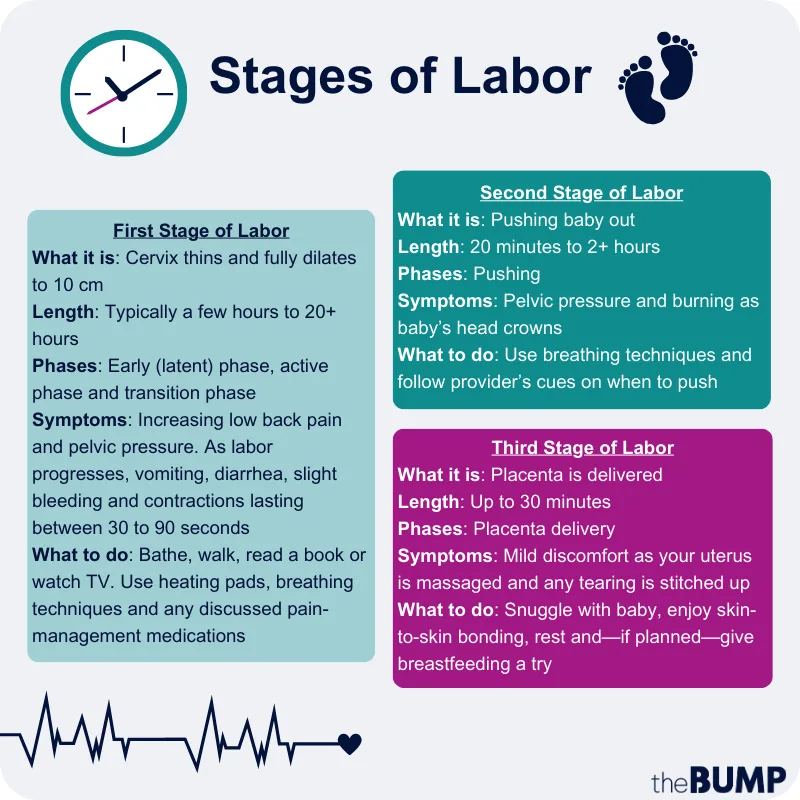What to Know About the Different Stages of Labor
Going into labor means the finish line is officially in sight. And while the end of your pregnancy is quickly approaching, this grand-finale event may be filled with dramatic twists, surprising turns and—let’s be honest—a fair share of pain and anxiety. Often, there’s a sequence of steps—known as the stages of labor—that take you from those early mild contractions to that incredible moment when you finally meet baby. Of course, every labor and delivery can progress a bit differently. (And, let’s be clear, unplanned or emergency C-sections and other possible hiccups can throw this whole expected progression for a loop.) Still, if you’re planning on trying for a vaginal delivery, you may want to get a better understanding of how things will pace and what to expect throughout.
There are three stages of labor and childbirth—and within those stages there are additional phases of labor as your body prepares to push baby out. Wondering approximately how long will it last from start to finish, and what to expect throughout? Here’s everything you need to know about the different stages and phases of labor.
Per the American Pregnancy Assocation (APA), there are three stages of labor and delivery. The first stage involves three phases: the early labor phase (also known as the latent phase of labor), active phase of labor and transition phase of labor. During this first stage of labor, you’ll have contractions to help the cervix thin out (i.e. efface) and fully dilate to 10 centimeters.
The second stage of labor is quicker; this is when you’ll actually push baby out. The third stage of labor is the shortest and involves delivery of the placenta. Read on for a more in depth look at all the stages and phases of labor.
The first stage of labor—which includes the latent, active and transition phases of labor—starts with the beginning of regular and consistent contractions and lasts until the moment you start pushing. It may take a few hours. It may even go on for a day or two. Many doctors will tell you that this stage can be prolonged for first-time moms, but that it’s often shorter in subsequent pregnancies. Either way, it’ll definitely test your mental and physical resolve. What’s important is that you find the support you need at each and every point—whether it’s experimenting with different labor positions, relying on help from a partner or loved one or finding effective pain relief.
Latent phase of labor
The movies lie. Rarely does a woman know the second she goes into labor with 100 percent certainty. In real life, it can be hard to determine if you’re actually about to have a baby. (Don’t worry, you’ll figure it out!)
Those initial contractions might feel like lower back pain, or they may ebb and flow somewhat erratically. “False labor will go away with rest and hydration, and Braxton Hicks contractions will ease up after an hour or two,” says Nina Hinting, MD, an ob-gyn at New England Women’s Healthcare in Woburn, Massachusetts. “True labor will continue and continue to worsen.”
As your cervix starts to thin and dilate, the early contractions will hopefully be light enough for you to talk and walk through them, explains Hinting. You may also notice a clump of clear or pinkish discharge from your vagina—that’s your mucus plug, which blocks the cervical opening during pregnancy. Hinting recommends doing what you can to relax and keep your mind off any discomfort you feel during the latent phase of labor. Take a bath or shower, read a book, watch TV or take a stroll. Better yet, sleep if you can; you’ll want to conserve your energy for later.
Active phase of labor
Once the strength of your contractions intensifies and the discomfort makes it hard to talk, walk or find a comfortable position, you’re probably moving into active labor. “When the contractions are three to five minutes apart and they’re lasting a full minute from start to finish, that usually means we’re moving into a more active phase,” says Christina M. Kocis, CNM, director of the Division of Midwifery at Stony Brook Medicine in New York. The active phase of labor typically begins when a mom-to-be is between 4 and 6 centimeters dilated. (FYI, if you haven’t called your doctor or midwife yet, now’s the time to ask about heading to your chosen hospital or birthing center.)
Still not sure if you’ve reached the active phase of labor? Here are some additional signs to watch for, according to Hinting:
-
You’re having gastrointestinal side effects. As baby drops toward your pelvic wall, you may experience diarrhea or vomiting.
-
Lots more pelvic pressure. Things may start feeling pretty intense down there.
-
Bleeding. A bit of bleeding is normal. To be safe, tell your doctor or midwife about any sign of blood.
-
You have an urge to push. You may want to bear down, but try and resist pushing until you’re advised to do so by your doctor, midwife or nurse.
Another potential sign you’ve entered the active phase of labor? Your water may break. While it’s possible for this to happen in the early stages of childbirth, it’s more likely to occur as things start heating up. If you’ve ruptured your amniotic sac, you might feel a sudden gush or a steady trickle. Either way, expect enough fluid to soak your clothes or sheets.
By this point, things have gotten pretty real. Kocis recommends moving around, sitting on a Pilates ball or taking a shower to see if the warm water helps you cope with the pain of contractions. Meditate or do your breathing exercises if it’s in your plan, and definitely turn to your support person—your partner, doula, nurse or midwife—for encouragement. Sip water to stay hydrated, and if you’re hungry, eat if you’ve gotten the green light. Smaller snacks are best, since “digestion isn’t super-efficient during labor,” says Kocis. (Some doctors may not allow you to eat—or may restrict your diet—during active labor in case a C-section becomes necessary.)
Wondering how long active labor lasts? Eager as you may be to get this show on the road, the frustrating reality is that it’s different for everyone. But you can typically expect that it’ll take anywhere from four to eight hours for your cervix to dilate close to 10 centimeters, according to Mayo Clinic.
First pregnancy, I noticed a little leaking and lower back pains. The next night, my water broke while I slept and the contractions came soon after. Water broke at 1 a.m. and I delivered at 5:40 p.m. later that same day. Second pregnancy, I went into preterm labor… I threw up before the contractions started… I lost my mucus plug—went to the hospital at 8 p.m. and gave birth at 3 p.m. the next day.
Transition phase of labor
The pain and pressure in your body both intensify during the last part of the active phase of labor as you transition from being dilated 8 centimeters to a full 10. Contractions will feel like they’re on top of each other and can last anywhere from 60 to 90 seconds.
If you’ve chosen to have a medication-free experience, the transition phase of labor may have you curling your toes, gripping the bed rails and grunting out loud. You’ll likely be exhausted (even with an epidural), and you may feel your confidence slipping. This is “not unusual at this point,” says Kocis. “This is where support is really important; your support person should step up in helping build your confidence and letting you know you can do this.” Hinting agrees, and reminds moms to keep the end goal in sight: “At this point we tell mothers to focus on the baby and on her breathing… We tell them this will be over sooner rather than later.”
Here are a few simple suggestions from Hinting on how to help manage the pain:
- Lower back massage and/or counter pressure applied to your back
- Heating pads applied to your lower back
- Slowing down your breathing, if possible
Once you’re fully dilated, you’ve officially made it through the first stage of labor. Your energy may seem depleted at this moment, but the hard work is just getting started. Welcome to the second stage of labor—aka the birth of baby.
Depending on your circumstance, you might have some extra time to rest before delivery begins. This may be the case if your epidural is preventing you from feeling any pressure down there. In fact, your medical team might “dial back some of the numbness,” says Hinting. This will help you regain some control and feel that urge to push.
How long does the second stage of labor last? There are a host of factors that influence how much time you’ll spend pushing, says Kocis. These include:
- Baby’s size and position
- Your body shape and pelvis size
- Your ability to push
- How tired you are
- The impact of an epidural, if you had one
Suffice to say, it could be minutes or it may be hours. Hinting says that you may feel burning when baby’s head is crowning; this sensation is often a sign that a few more pushes will do the trick. The head will be delivered first, followed by the rest of baby’s body. Your doctor may wait a few minutes to clamp and cut the cord; delaying this process by a few minutes has been shown to give baby a healthy head start.
I was shopping when contractions started. I drove home, put the shopping away, got taken to hospital and bubs born—all in 52 minutes.
If all goes well, you’ll probably be too busy snuggling baby to pay much attention to the third stage of labor, which is delivery of the placenta. “Most of the time it comes out without much maternal effort within the first 10 minutes after birth,” says Hinting. “Some women notice it, some don’t.”
It’s safe to say that delivering your placenta is not as dramatic (or painful) as pushing out a baby. If you have contractions at this point, they’re likely pretty mild. Your doctor or midwife may ask you to push once or twice, and they may gently massage your stomach to examine your uterus, which “doesn’t feel phenomenal,” says Kocis. “But once that placenta is out, moms feel very good and [have] that final sense of relief.” Your doctor or midwife will carefully examine your placenta, and will determine if you need stitches to repair any vaginal tears.
Wondering what happens after baby is born and the placenta is out? Per the APA, you and baby will likely be monitored for the next few hours. For mom, your provider will want to ensure:
Your uterus is contracting to shrink back down in size Bleeding isn’t excessive Any vaginal tears are sutured up A smooth start to breastfeeding, if planned
The epidural is removed if you opted for one
For baby, according to Meleen Chuang, MD, an ob-gyn and medical director of women’s health at the Family Health Centers at NYU Langone, your provider will ensure:
They’re healthy with stable vitals and breathing They’ve received their vitamin K shot and eye drops
How long can labor last? As noted, how long labor lasts will vary widely depending on personal circumstances and factors, such as whether you’re in spontaneous labor or had a labor induction, history of c-section and how big baby is. The first stage of labor can last anywhere from a few hours to over 20 hours, “with early labor often lasting the longest,” Chuang notes. The second stage of labor will usually last anywhere from 20 minutes to around two hours, and can be on the longer side for first-time moms. The third stage of labor can last anywhere from a few minutes to up to a half hour.
Frequently Asked Questions
How long do contractions last?
Like all other aspects of labor, how long your contractions last will also vary. “In the first stage, contractions can last 30 to 60 seconds and may become more frequent and intense as labor progresses,” Chuang notes. As labor moves into the second stage, contractions can last between 60 and 90 seconds and occur every two to three minutes. Contractions are typically most intense in this stage of labor, she adds. In the third stage of labor, contractions are typically much less intense, shorter and less frequent, only occurring every few minutes to help you deliver the placenta.
Is there a fourth stage of labor?
Medically, there are only three stages of labor and delivery. However, some experts refer to the recovery and monitoring done in the hospital for a few hours after the birth as the fourth stage of labor.
How does labor start?
When and exactly how labor will start depends on factors such as your body’s readiness, stress levels, physical activity levels and more, Chuang explains. But once your body is ready, baby’s brain will signal Mtom’s body to release certain hormones to prepare for labor. This includes prostaglandin, which helps soften the cervix.
The stages of labor will test your mental and physical fortitude. “The labor experience is unique,” Chuang says. “Support from partners, family and healthcare professionals can greatly impact the comfort and emotional well-being of the mother during labor.” Remember, it’s okay if things don’t go exactly as expected. Keep your eye on the prize.
Can you not know you're in labor?
It’s pretty rare for someone to remain fully unaware throughout labor. That said, since early labor can happen over the span of days and symptoms vary, it might take a while to realize what’s happening, says Nicola Perlman, MD, an ob-gyn and clinical fellow at Stanford Medicine Children’s Health. That said, once you’re officially in active labor, it’s pretty hard to miss!
Please note: The Bump and the materials and information it contains are not intended to, and do not constitute, medical or other health advice or diagnosis and should not be used as such. You should always consult with a qualified physician or health professional about your specific circumstances.
Plus, more from The Bump:
Meleen Chuang, MD, is an ob-gyn and medical director of women’s health at the Family Health Centers at NYU Langone, as well as the chief of obstetrics and gynecology at NYU Langone Hospital in Brooklyn, NY. She earned her medical degree from SUNY Stony Brook.
Nina Hinting, MD, is an ob-gyn at New England Women’s Healthcare in Woburn, Massachusetts. She earned her medical degree at McGill University Faculty of Medicine in Montreal, Canada.
Christina M. Kocis, CNM, DNP, is the director of the Division of Midwifery at Stony Brook Medicine in New York, where she also earned her degrees.
Nicola Perlman, MD, is an ob-gyn and clinical fellow at Stanford Medicine Children’s Health. She earned her medical degree from Harvard Medical School and completed her residency at Brigham and Women’s Hospital/Mass General Hospital.
American Pregnancy Association, First Stage of Labor
Mayo Clinic, Stages of labor and birth: Baby, it's time!, July 2024
American Pregnancy Association, Third Stage of Labor
Learn how we ensure the accuracy of our content through our editorial and medical review process.
Navigate forward to interact with the calendar and select a date. Press the question mark key to get the keyboard shortcuts for changing dates.





















































